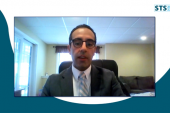Multiarterial Grafting in CABG Triumphs Again in Large Database Study
Surgeons who have, for decades, been advocating for multiarterial grafts say it’s time for outdated habits to change.

SAN ANTONIO, TX—Ten-year data from more than a million patients undergoing isolated CABG once again confirms the survival benefit of multi- over single-arterial grafting in all but patients who are severely obese.
“These findings support expanded use of multiarterial grafting for nearly all coronary surgery patients and establishes a benchmark for comparison to other therapies for multivessel coronary disease,” said Joseph F. Sabik III, MD (University Hospitals Cleveland Medical Center, OH), who presented the findings here at the 2024 Society of Thoracic Surgeons (STS) meeting as a late-breaking study.
To TCTMD, Sabik acknowledged the countless data already available showing the advantages of using more than one arterial graft when performing CABG, but could only guess as to what is holding surgeons back from moving in this direction. “Some people will say it's lack of education; they weren't trained on how to do it,” he said. “Some people just don't believe the evidence. So, we just keep working forward trying to show more benefit, create more educational opportunities to get people comfortable with that.”
Commenting during the session, John Puskas, MD (Mount Sinai Beth Israel and Mount Sinai Morningside, New York, NY), called the study “the most important paper that will be presented at this meeting.” He recalled asking 20 years ago why using a second arterial conduit wasn’t a quality metric and questioned again why “we haven't as an institution and as a society guided ourselves” in that direction.
Ten-year Data
For the study, which was simultaneously published in the Annals of Thoracic Surgery, Sabik and colleagues linked data from the STS Adult Cardiac Surgery Database to the Centers for Disease Control and Prevention’s National Death Index to look at 1,021,362 patients undergoing isolated CABG at 1,108 programs between January 2008 and March 2019. Overall, 9.83% of patients received multiple arterial grafts, and patients were followed for a median 5.3 years.
Those who underwent multiple-arterial grafting were on average younger (mean 60 vs 66 years) and more frequently male (85% vs 75%) than those who received single-arterial grafts. They also had less hypertension; diabetes; and lung, cerebrovascular, and/or peripheral arterial disease.
In a propensity-matched analysis, operative mortality was similar at 1% for both groups. All patients undergoing single-arterial grafting had single internal thoracic artery (SITA) or saphenous vein grafts, whereas in the multiarterial-grafting group, 46% had a SITA and radial artery, 47% had bilateral internal thoracic artery and saphenous vein grafts, and 8% had bilateral internal thoracic artery, radial artery, and saphenous vein grafts.
We have to continue to move our field forward. Joseph F. Sabik III
Ten-year survival was significantly better for patients who received multiple over single arterial grafting (adjusted HR 0.87; 95% CI 0.85-0.88), and this was maintained regardless of coronary disease type, LV function, surgical priority, and cardiopulmonary bypass use. The survival benefit of multiarterial grafting was greater for men than women and also increased with younger age. Additionally, the magnitude of survival benefit decreased with increasing levels of heart failure, chronic lung disease, and renal dysfunction.
Survival was similar between multiple and single arterial grafts in patients with severe organ dysfunction, specifically those with NYHA class IV heart failure, severe chronic lung disease, and chronic kidney disease with eGFR < 45 mL/min/1.73m2.
The only standout appeared to be patients with severe obesity (defined as body mass index > 40 kg/m2), in whom single versus multiple arterial grafting was associated with better survival (adjusted HR 1.08; 95% CI 1.01-1.16).
Center volume did not seem to have an effect on the survival benefit associated with multiarterial grafting, except for programs with volumes fewer than five cases per year, where survival was better with single arterial grafts.
Sabik urged operators to use “clinical judgement” when deciding what to do in these surgeries. “In all honesty, we're too low in multiarterial grafting,” he said. “Do we need to be 80-90% to get benefit? I don't think so. But we need to get over 50-60% as a surgical community.”
Moving Forward
Following the presentation, session co-moderator Elaine Tseng, MD (University of California San Francisco and San Francisco VA Medical Centers), mentioned the ongoing ROMA trial and questioned whether those eventual results along with these data would be enough to change guidelines.
That’s unclear, Sabik responded. “Cardiologists don't like looking at observational data as much as we do,” he said. “That's a little bit of a difference between the two fields. We put some weight into observational trials and studies where they tend not to.”
Regardless, Sabik continued, “it's very hard to find patients that don't benefit [from multiarterial grafting]. Some have similar outcomes. That's not a bad thing. But . . . it's hard to figure out who will benefit and who not.”
As for why patients with severe obesity might not fare well with multiple arterial grafts, Sabik said it’s possible that the effect of “sternal nonhealing or sternal infection” in that group could play a role. However, he acknowledged, it “might be that they just have so many other comorbidities as well that they just don't derive a benefit because they are not going to live long enough to get a benefit.”
How long have we been talking about this? Andrew Pruitt
Audience member Andrew Pruitt, MD (Trinity Health, Ann Arbor, MI), questioned the stagnation of the mutliaterial grafting rate in the STS database and how to bring about change. “How long have we been talking about this?” he asked. “And if you look at the STS data, we’re stuck at 14-15% multiarterial grafting if you look at the totality of isolated CABG. So we are trying to move this needle.”
Sabik reassured that this is a top priority issue for the STS, noting that it’s why the organization supported this study, though observational, and featured it as a late-breaker.. “The first thing is evidence and data,” he stressed. “There is a lot of effort, but change management is hard. It’s slow. It's a lot slower than we all think. I’m always impressed by how quickly cardiology advances. In all honesty, they move very, very quickly. We do not move as quickly as they do, and I think that we need to adopt that strategy. We have to continue to move our field forward.”
Yael L. Maxwell is Senior Medical Journalist for TCTMD and Section Editor of TCTMD's Fellows Forum. She served as the inaugural…
Read Full BioSources
Sabik JF, Mehaffey JH, Badhwar V, et al. Multi-arterial versus single-arterial coronary surgery: ten year follow-up of one million patients. Ann Thoracic Surg. 2024;Epub ahead of print.
Disclosures
- The study was supported by The Society of Thoracic Surgeons.





Comments